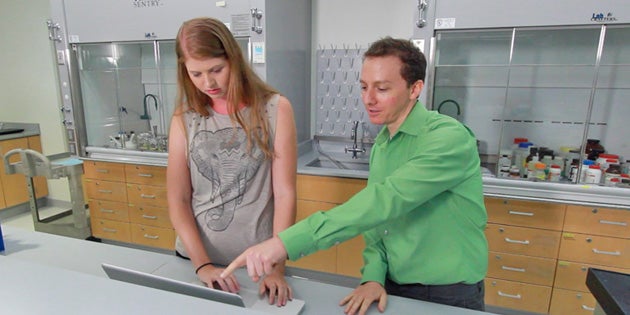If a picture is worth a thousand words, then a picture that can rapidly and cheaply help diagnose life-threatening diseases in developing countries may be priceless.
Joe Carson, assistant professor of physics and astronomy at the College of Charleston, is part of a research team that has developed an innovative and low-cost diagnostic imaging tool that could help prolong or save the lives of cancer patients in Africa.
The project was recently selected as one of 25 semifinalists in the Global Action Challenge, a competitive investment program that identifies innovations with the potential to have a transformative impact on health and food. The prize is $1 million. Finalists will be announced in October 2014.
Though relatively rare in the United States, a type of cancer known as Kaposi’s Sarcoma (KS) is the most common type of cancer among men in Mozambique, a country of some 24 million people in Southeast Africa. KS is the second most common cancer among the country’s women.
Imaging technologies are vital in identifying and monitoring tumors and legions caused by the disease, which is typically associated with the AIDS infection. But traditional imaging tools such as MRIs and 3D ultrasounds can cost upwards of $3,000 per diagnosis.
Carson and researchers from the University of California San Diego devised an alternative imaging method using a standard digital camera, software they wrote themselves and a specially designed adaptor. The small, battery-powered camera, which costs about $200, dramatically reduces the cost of imaging to 75 cents per diagnosis.
RELATED: Watch a video that explains how the imaging technology works.

The researchers modified a Lytro digital camera with a special adaptor and software they wrote themselves.
Using the modified camera, healthcare workers in Mozambique’s largest public hospital are able to take photographs of suspected KS tumors and digitally transmit the images to other parts of the world for analysis and diagnosis.
Because the individuals taking the images might be working in remote areas, the researchers had to design a system that could upload images using only a low-bandwidth mobile phone signal. But once an image is successfully transmitted, it could save a life.
Hannah Wilson, an undergraduate biology major at the College who has been closely involved on the software side of the project, says the images produced by the camera contain enough information for a clinician in the United States to possibly diagnose whether a cancer has become malignant.
Carson says the technology that the made the project possible is actually quite simple. By differentiating between the focused and unfocused parts of a digital image, the software can extract depth and height information from the snapshot. This information is key to identifying and diagnosing the size and severity of the skin lesions that are symptoms of the disease.
“We turned what would ordinarily be a two-dimensional, flat snapshot into a full, three-dimensional rendering,” Carson says.
In addition to $129,000 in seed funding from the National Institutes of Health, the project also has attracted notice from the business community. Just this week, Carson learned that the project is a finalist for a The InnoVision Awards Program, aSouth Carolina organization that recognizes technological advancements and commercial innovations. The results will be announced in November 2014.
So how did Carson, who is better known around the College and in scientific circles for his work in astronomical imaging, get involved with a healthcare-related project?
RELATED: Read how Professor Joe Carson and undergraduate students discovered a new extrasolar planet.
Astronomy and healthcare have a lot in common from an imaging standpoint, Carson says. “The laws of physics and optics are the same whether you are working with a high-powered telescope or a small digital camera.”
In fact, two of the challenges that the team working on the imaging project had to overcome – sending images over slow connections and extracting useable information from poor quality images – are the same problems often encountered in planetary research, Carson says.
While they await the results of the Global Action Challenge competition, the research team is already working to identify other possible applications for their invention.
“Doing it at such a cheap cost – about 75 cents for the diagnosis – should be broadly applicable,” Carson says. “And we are working hard to try to find other applications that would be useful to apply this technology toward.”







